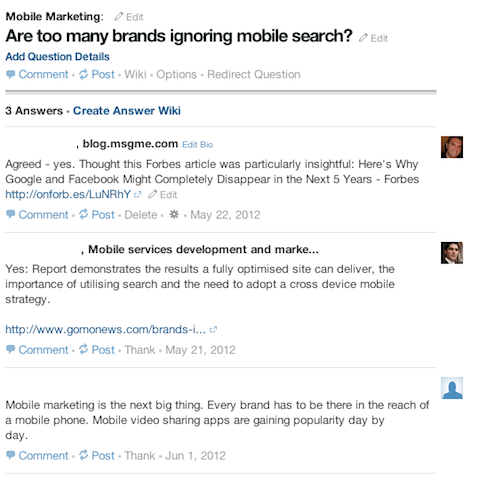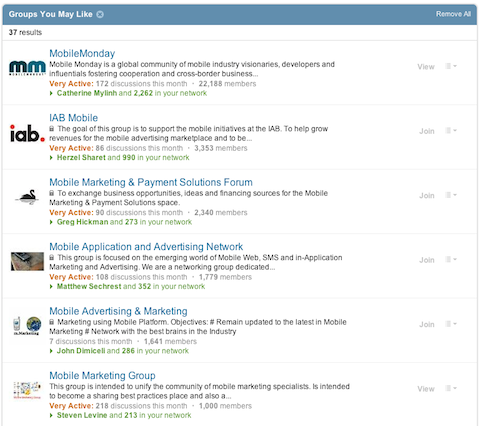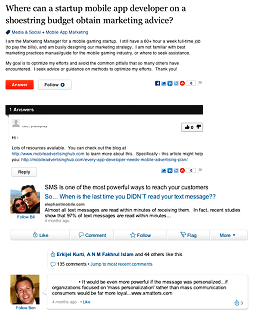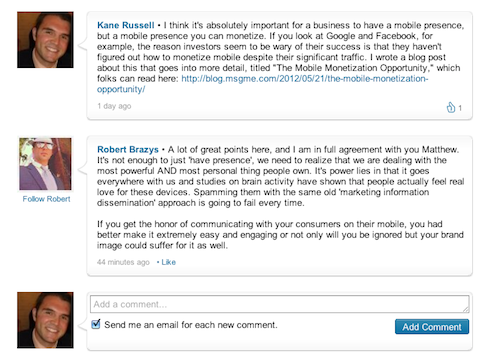 How should business-to-business (B2B) marketers best use question-based social forums?
How should business-to-business (B2B) marketers best use question-based social forums?
For business-to-business companies in particular, LinkedIn Groups, Quora and HighTable are just three examples of forums where marketers can demonstrate their knowledge.
In this article I'll cover how B2B marketers can best approach these sites and provide eight recommendations for generating qualified leads and driving sales.
Note: The examples used all come from actual Q&A site conversations, with names removed for privacy purposes.
Overview of Question and Answer–Based Sites
When Q&A social media sites first came out, they were intended for people to exchange ideas and gather information. Unfortunately spammers and non-experts took away from their usefulness for a while.
But a few recent factors have brought Q&A social media sites back into the fold:
- There's a proliferation of social media profiles where contributors have an actual identity to maintain. Posting unhelpful answers can hurt a person's social media reputation significantly now.
- It's harder to find answers to specific questions because there are over 500 million URLs today. Internet searches can be overwhelming.
- The salesy quality of Internet search ads can turn off a B2B audience. B2B searchers seek guidance, not a sales pitch.
- Social media sites have become more specialized (and well-funded). Sites like LinkedIn, HighTable and Quora provide direct access to a specific type of audience.
As a result, B2B marketers have an opportunity to consider: a captive and specific audience looking for guidance on issues that often relate directly to the problem or issues B2B marketers are trying to solve.
Here are eight tips that, when taken together, will result in more leads and increased sales.
#1: Comment from the Perspective of a Thought Leader
Above all, marketers have to position and think about themselves on Q&A sites as the thought leader for their particular business. Approaching a Q&A forum like a used car salesman approaching a browser will alienate the target audience.
Prospects on Q&A social media sites are usually in a higher position on the sales funnel. Aggressive tactics do not resonate here. Instead, take on the voice of a thought leader, which requires the following:
- Answer questions up front: People who go to Q&A sites are looking for answers to questions, not wishy-washy stances. Answer the initial question directly and then provide supporting evidence to back up the claim.
- Provide both qualitative and quantitative supporting evidence: Obviously having data and insight about certain topics is not possible in 100% of cases. That said, opinions backed by data or hard numbers carry more weight. But providing just numbers will not impress either. There has to be an interpretation of the numbers to demonstrate a position of expertise.
- Acknowledge alternative solutions: Remember, people are not perusing Q&A sites for a sales pitch. They are seeking a well-thought-out opinion. Failure to acknowledge alternatives or other options makes for a weak point of view.
- Write clearly and concisely: Perhaps this goes without saying, but typos or run-on sentences will not wow prospects.


As potential customers start seeing more of these types of answers, they'll engage directly with the individual.
#2: Respect Other Users
To use the words of Gary Vaynerchuk, creator of Wine Library TV and author of Crush It!, “Taking the high road is undefeated.” No amount of posturing, shameless self-promotion or insulting others will impress potential customers in a Q&A forum.
In the example below, a potential customer with a different viewpoint could respond more positively to address limitations in a way that respects (or better yet, understands) other people's choices.

This is not to say that marketers should not address other users entirely. Disagreement within a Q&A flow produces some of the best opportunity for a savvy marketer to make headway with potential customers.
Get World-Class Marketing Training — All Year Long!
Are you facing doubt, uncertainty, or overwhelm? The Social Media Marketing Society can help.
Each month, you’ll receive training from trusted marketing experts, covering everything from AI to organic social marketing. When you join, you’ll also get immediate access to:
- A library of 100+ marketing trainings
- A community of like-minded marketers
- Monthly online community meetups
- Relevant news and trends updates
The best advice is to remember the adage, “show, don't tell.” Address disagreements using examples and data to make a point instead of going into attack mode.

#3: Join in a Conversation
Have you ever been to a social event where someone interrupts a conversation with an unrelated point, essentially derailing others' interest in the topic of discussion? The same faux pas applies to Q&A sites.

To take on a more conversational tone, respond directly or acknowledge what others have already stated. This works best for recently posted questions, as there are not as many comments to go through. Ideally, chime in early to a question that eventually receives a significant following.
In addition, take advantage of the functionality available on Q&A sites to stay in the loop.
For example, check the box on LinkedIn to receive an email digest of each new comment.
The LinkedIn digest feature helps you continue to be part of the conversation.

#4: Be Consistent and Cover the Subject Matter Comprehensively
The odds are tiny that a single, brilliant answer will convince a potential buyer to call into a sales line. To increase those odds, post thoughtful answers across a number of topics related to your business.
For example, an executive at a marketing software company should target multiple forums (forums meaning multiple groups on LinkedIn, topics on Quora, etc.) that address not just software, but also digital marketing, relationship marketing, software as a service or anything else related to the business.

Discover Proven Marketing Strategies and Tips
Want to go even deeper with your marketing? Check out the Social Media Marketing Podcast! Publishing weekly since 2012, the Social Media Marketing Podcast helps you navigate the constantly changing marketing jungle, with expert interviews from marketing pros.
But don’t let the name fool you. This show is about a lot more than just social media marketing. With over 600 episodes and millions of downloads each year, this show has been a trusted source for marketers for well over a decade.
Part of becoming a thought leader is demonstrating knowledge across an entire industry, not just one topic that directly relates. If you can, spend some time commenting on other topics outside your business experience. This increases perception of you as a thought leader focused on assisting others.

#5: Take a Long-Term View
It certainly takes time to post thoughtful answers across a number of topics. And it makes little sense for marketers to try to blanket everything in one day, given their schedules.
The answer is to take a long-term perspective. What works best is to answer one or two questions per day as part of a social media routine. This way, written ideas remain fresh and innovative, and Q&A site marketing will not become a huge time distraction.
Posting one to two answers per day requires only a few minutes, and after a month, roughly 30-40 questions will have received attention. This is an excellent base upon which to build over time. As more and more potential customers see compelling answers from the same person, they will start contacting the expert directly with questions and seeking advice.
All Q&A sites recognize active and engaged users. LinkedIn, for example, highlights influencers whose ideas lead to the most active discussions. This is essentially free branding.

Even more important, a long-term view best matches the spirit of Q&A sites and social media thought leadership in general. Trying to get a quick bang for the buck without spending the requisite time implies a lack of commitment or interest in a given industry.
Being a thought leader requires adjusting to changing market dynamics and helping the Q&A audience navigate those transitions.
#6: Be a Link Miner, Not a Link Farmer
The worst offenders of link farming are easily spotted. They post links with no relevance to the topic at hand, often all over a particular Q&A forum. Ultimately, this type of link farmer is the headache of the Q&A site, not marketers.
Quora, for example, has software that prompts users who do not include enough information to revisit and edit an answer.

However, responsibility for other types of negative link farming falls squarely on comments' authors. Consider the following examples:

In the first example, the author answers a question with just a number of links. In the second, the author throws a link into an answer that's not particularly relevant to the topic at hand. The issue being that everyone knows the intention behind the answers, namely “go to my website.”
This call to action is very different from “I'm trying to help you with some useful information.” For a Q&A strategy to work, the second approach is mandatory.
Which brings us to the concept of a link miner. One of the best attributes of marketing via Q&A sites for B2B marketers is the ability to rapidly increase daily web visits. With increases of 2-4 times readily attainable, sharing links on a Q&A forum is a huge part of the strategy.
The trick, however, is to share those links within the context of thought leadership. Do not just throw them out there without context. Think instead like a miner, where a potential customer digging through information is pleasantly surprised by discovering a useful web link. Miners use the following tactics:
- Include a link only if relevant.
- Explain a link within a context of a greater answer.
- Remember that the underlying message behind the link is “useful information,” not “check out my site.”

#7: Start Your Own Q&A Forum on LinkedIn
Given the social nature of Q&A sites, the same rule applies: interact. A great way to achieve this is to post questions to the Q&A site community or, even better, create a forum or question flow that acts as an information hub for other interested parties.
The challenge is that maintaining something like a LinkedIn Group takes time. Creating a thriving community requires marketing, engaging and prompting others. Essentially you should prepare for an event marketing type of role. If the resources are there, take the initiative, but Q&A site marketing can still produce results without this extra effort.

#8: Respond To and Use Direct Messaging
Direct messaging on Q&A sites has two forms: outbound (marketers reaching out) and inbound (marketers receiving correspondence). With regards to outbound, Q&A marketing becomes more of an art than a science.
Simply, if a potential customer seems to take an interest in multiple responses, take the initiative to reach out to the individual directly using the Q&A site's direct messaging functionality.
The advantage being that an exchange on a Q&A site provides an extremely warm introduction and a reason to reach out. Use outbound tactics sparingly, however, as jumping the gun more or less equates to spamming users.

Interestingly, this type of communication would never have worked if done via email, demonstrating the power of Q&A site direct messaging.
Inbound direct messaging, on the other hand, remains much more straightforward. When an individual reaches out, respond. The key in the inbound case is timing. People on Q&A sites want immediate answers, so respond as soon as possible (though anything less than a few hours will be acceptable).
With an established thought leadership presence, inbound direct messaging from a Q&A site will most often be a potential customer reaching out with a business proposition. That's when the time invested up front starts to pay off.
Putting it all Together
When you use these eight recommendations together, you'll have a strong starting point to develop a powerful B2B marketing strategy.
What do you think? Which strategies have you found to be most effective? Please voice your opinion by posting to the comments box below.
Attention Agency Owners, Brand Marketers, and Consultants

Introducing the Marketing Agency Show–our newest podcast designed to explore the struggles of agency marketers.
Join show host and agency owner, Brooke Sellas, as she interviews agency marketers and digs deep into their biggest challenges. Explore topics like navigating rough economic times, leveraging AI, service diversification, client acquisition, and much more.
Just pull up your favorite podcast app, search for Marketing Agency Show and start listening. Or click the button below for more information.

